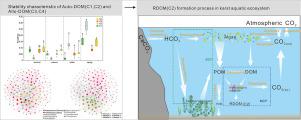Water Research ( IF 11.4 ) Pub Date : 2022-06-07 , DOI: 10.1016/j.watres.2022.118723 Fan Xia 1 , Zaihua Liu 2 , Min Zhao 3 , Qiang Li 4 , Dong Li 5 , Wenfang Cao 6 , Cheng Zeng 3 , Yundi Hu 3 , Bo Chen 7 , Qian Bao 8 , Yi Zhang 9 , Qiufang He 10 , Chaowei Lai 11 , Xuejun He 1 , Zhen Ma 6 , Yongqiang Han 1 , Haibo He 6

|
Biological carbon pump (BCP) in karst areas has received intensive attention for years due to their significant contribution to the global missing carbon sink. The stability of autochthonous dissolved organic matter (Auto-DOM) produced by BCP in karst aquatic ecosystems may play a critical role in the missing carbon sink. However, the source of dissolved organic matter (DOM) in inland waters and its consumption by planktonic bacteria have not been thoroughly examined. Recalcitrant dissolved organic matter (RDOM) may exist in karst aquatic ecosystem as in the ocean. Through the study of the chromophoric dissolved organic matter (CDOM) and the interaction between CDOM and the planktonic bacterial community under different land uses at the Shawan Karst Water-carbon Cycle Test Site, SW China, we found that C2, as the fluorescence component of Auto-DOM mineralised by planktonic bacteria, may have some of the characteristics of RDOM and is an important DOM source in karst aquatic ecosystems. The stability ratio (Fmax(C2/(C1+C2))) of Auto-DOM reached 89.6 ± 6.71% in winter and 64.1 ± 7.19% in spring. Moreover, correlation-based network analysis determined that the planktonic bacterial communities were controlled by different fluorescence types of CDOM, of which C1 (fresh Auto-DOM), C3 (conventional allochthonous DOM (Allo-DOM)) and C4 (the Allo-DOM mineralised by bacteria) were clustered in one module together with prevalent organic-degrading planktonic bacteria; C2 was clustered in another tightly combined module, suggesting specific microbial utilization strategies for the C2 component. In addition, some important planktonic bacterium and functional genes (including chemotrophic heterotrophs and photosynthetic bacteria) were found to be affected by high Ca2+ and dissolved inorganic carbon (DIC) concentrations in karst aquatic ecosystems. Our research showed that Auto-DOM may be as an important carbon sink as the Allo-DOM in karst ecosystems, the former generally being neglected based on a posit that it is easily and first mineralized by planktonic bacteria.










































 京公网安备 11010802027423号
京公网安备 11010802027423号